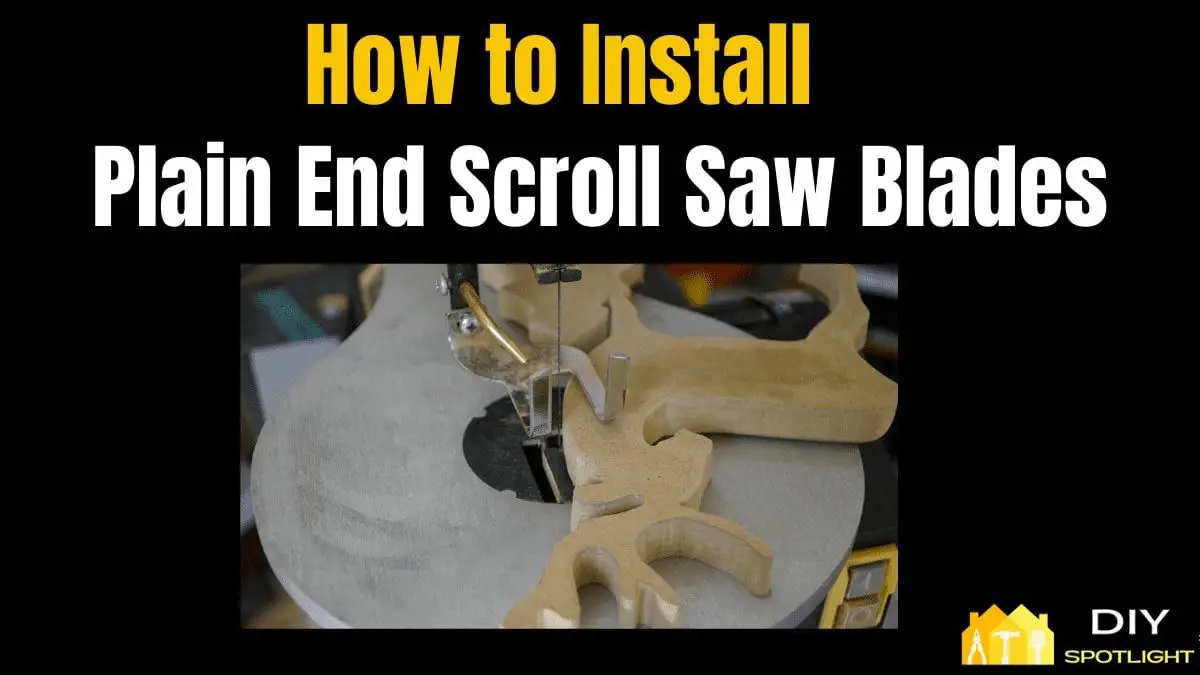Updated 3/24/2024
Installing plain end scroll saw blades can be a bit perplexing, especially if you’re new to the scroll saw. But fear not!
In this post, we’re going to demystify the process, breaking it down into simple, easy-to-follow steps.
Whether you’re a seasoned woodworker or just starting out, this guide will have you swapping out blades and diving into your projects with confidence in no time.
Let’s get that scroll saw set up and ready to go!
How to Install Plain End Scroll Saw Blades
Safety First

Safety should be your priority whenever using or maintaining a power tool. They hold a host of stored energy which, if released at the wrong time, can lead to deep cuts, lacerations, lesions, and in severe cases, death by electrocution.
Unplug the power plug for your scroll saw before changing its blade. If multiple people use the machine, make sure that you leave a note tied to the machine’s main switch or circuit breaker to prevent accidental startups.
Wear protective gloves when maintaining your scroll saw as you’ll be handling the blade.
Getting the Scroll Saw Blade Assembly Ready
The assembly for plain saw blade scroll saws is going to depend on the brand you use. Account for all the components required.
In most cases, there will be the clamps, the blade, and an Allen key.
Some clamps already have a key on them and don’t require the Allen key, but if yours does, make sure it’s the right size for the clamp screws.
Inspect the clamps and blade, making sure they are in good condition and don’t have any signs of rust or damage, as this will impact your saw’s functionality and is also a safety hazard that may cause the blade to fly off.
Clamping the Scroll Saw Blade

- Grab your blade and one of your clamps. Guide one end of the blade through one of the openings on the clamp that runs between the two hex screws, ensuring that the cutting edge is in the correct orientation.
- Ensure that the end of the blade runs through both of the screw surfaces but doesn’t go out from the other end; otherwise, you won’t have enough blade length for the other clamp.
- Screw the blade in place by tightening the hex screw with an Allen key or the tightening screw on the clamp, ensuring that the blade is held firmly in the middle of the two screws.
- Don’t over-tighten the screws, as this may damage the threads. You can consult your scroll saw’s manual on tightening guides. Generally, half to one rotation should suffice when tightening.
- Hold the blade and clamp upright and make sure that the blade runs straight down the clamp. Significant deviations from the normal may cause the blade to kink and break when in use, so make adjustments if necessary.
- Install the other clamp in the same way on the other end of the blade and inspect again for straightness. Some scroll saws come with a guide on their upper arm where the whole blade assembly can be placed for accurate blade installation.
Installing the Blade Assembly in the Saw
Depending on the type of scroll saw you have, it may have a removable throat plate for inserting the blade assembly or may have a slit for guiding the blade assembly through the table.
In either case, a clamp-holding mechanism should be under the table where the clamp hooks onto or snap-in.
Find that lower inner hook and place one arm of the clamp onto the hook.
Keep medium to low tension on the upper clamp before hooking it onto the upper clamp holder above the table. Tighten the blade using the blade tension adjustment knob.
Adjusting the Tension
After you’ve installed the blade with its assembly, your work isn’t over yet.
Plug your saw back into the mains supply and run the saw for a couple of minutes, and you’ll see that the blade loosens.
That’s because the blade tends to stretch the first time the saw is turned on.
You must account for this phenomenon and adjust the tension again using the tension adjustment knob or a lever on the upper clamp holder.
And there you have it! Your new blade is installed.
Wrapping it Up
It is worth mentioning that not all scroll saws are created equal. Some are only manufactured to hold pinned blades, some only for plain, and some can hold both blades or may have an aftermarket attachment that allows them to hold both.
For the scroll saws that only hold plain blades, their clamps may not require coming off from the upper and lower arms, and the blade requires clamping by tightening it between the clamps.
You should consult your owner’s manual if you’re still unsure about this process. It’ll definitely have a section on how to install plain-end scroll saw blades.
If your scroll saw still doesn’t function properly, the chances are that the blade you replaced was dull, the motor inside the saw is damaged or has dull contact brushes, or the threads in the clamp(s) have broken off.
Maintain a check sheet where you regularly maintain your scroll saw, checking to see its motor and other peripheral parts’ performance.
This will improve its longevity and give you consistent cuts every time.
Hopefully, this guide showed you how to properly install a plain end scroll saw blade!

